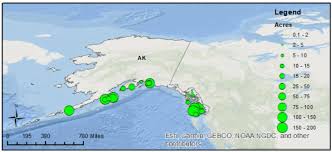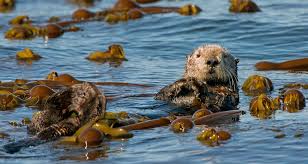The Alaskan Kelp Forest
The Endangered Alaskan Kelp Forest
By: Benito Casamatta
Location and Major Features
The Alaskan Kelp Forests are mainly found along the coastlines of Alaska, usually in the Gulf of Alaska, Aleutian Islands, and southeastern Alaska.
The kelp forests have large and dense amounts of brown algae, such as giant kelp aka Macrocystis pyrifera and bull kelp aka Nereocystis luetkeana. These species of come together and provide underwater structures that supports a wide range of marine life.
Uniqueness or Rarity
The Alaskan Kelp Forests have many unique features, and this is due to their enormous size and the environmental conditions they can endure, such as freezing temperatures and strong currents/tides. They are of the most productive and biodiverse marine ecosystems that play a crucial role in reducing carbon and coastal protection.
Biodiversity (Number of Species and Ecological Importance
The Alaskan Kelp forests support a more than twenty species of fish, invertebrates, marine mammals, and birds. Some notable species are sea otters, sea urchins, rockfish, sea lions, and even whales. Ecologically, the kelp forests provide an essential habitat and nutrients for many marine organisms to thrive. The forest supports fisheries and tourism industries and also help mitigate coastal erosion. They also reduce carbon emissions as mentioned previously!
Historical Comparisons to Present (Rates of Loss) and Human Impacts
Historical comparisons show that the kelp forests have been in a decline of over 80% over the last four decades of kelp biomass. This is due to many factors such as climate change resulting in ocean warming, ocean acidification as previously mentioned. Pollution including plastics and chemicals, and then overfishing of key species like sea otters and certain fish which makes the food chain unstable at times. These threats lead to habitat damage and loss of biodiversity.
Flagship Species of Place (Status of Species) and Threat to Species
The Sea Otter is the flagship of the Alaskan Kelp Forest and once hunted to almost near extinction, their population has rebounded in many areas but are still threatened by oil spills, climate change, and few predators including orcas. The decline in the sea otter population can lead to the overpopulation of sea urchins which then results in a diminish to kelp forests when their population isn’t controlled.
Proposed or Current Conservation Efforts
Some conservation efforts include the establishment of Marine Protected Areas (MPAs), monitoring and regulating fisheries, restoration of the sea otter population, and reducing pollution. Some proposed projects are more extensive use of geospatial tools to monitor the kelp forest health and the impacts of climate change by satellite imagery.
Geography and Geospatial Tools
Geographers use GIS remote sensing to map out and monitor the kelp forests. These models and images can assess the change over time and identify areas for protection. They give scientist an understanding of the spatial dynamics of the kelp forests and how environmental stressors affect the ecosystem.
Pleas for Help
You can Donate to organizations including Marine Conservation Institute and the Alaska SeaLife Center You can volunteer for cleanups and conservation projects.
Reduce and reuse plastic/recycle.
Buy from Sustainable Seafood companies by choosing seafood from certified sustainable fisheries.
Advocate and vote for policies that protect marine environments and address climate change.
Marine Conservation Institute: marine-conservation.org
Alaska Sealife Center: alaskasealife.org
Ocean Conservancy: oceanconservancy.org
National Marine Sanctuary Foundation: marinesanctuary.org
World Wildlife Fund: worldwildlife.org






Comments
Post a Comment